SEO
Time To Replace the Content Marketing Funnel (3 Alternatives)
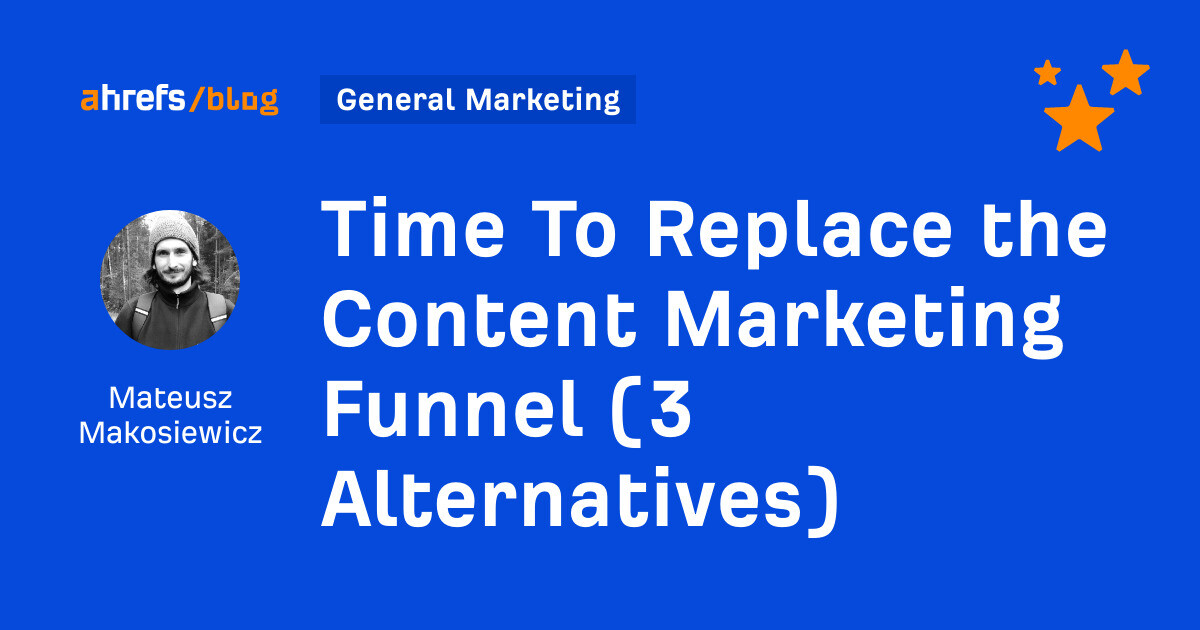
You won’t read anything good about the content marketing funnel in this article. Only bad things. Like, it’s too linear and simplistic to address the complexities of customer journeys.
If you need a framework to build your content strategy on, it should probably be a no-funnel framework instead. And there are very good reasons for it.
A funnel in marketing is a multi-stage process that guides potential customers from first learning about a product to making a purchase.
Depending on the version, it has 3 – 6 stages, and it looks something like this:
Traditionally, all content types have their designated place in each stage:
- Top: product landing pages, ebooks, guides, most social media posts, etc.
- Middle: webinars, case studies, lead nurturing programs, etc.
- Bottom: success stories, white papers, sales enablement materials, etc.
Makes sense, right? Not entirely.
It oversimplifies literally everything important for a content marketer. And because of that, the model gets some things completely wrong and ignores others.
This isn’t just theoretical. I’ve applied the funnel approach at various companies. Initially, it was reassuring, providing a sense of structure and control. However, the deeper I got, the more confusing it became. It started to seem like the sense of order was purely imaginary, as there was no reliable method to verify if people were truly following the funnel.
1. Misunderstands consumer behavior
The funnel model assumes a perfectly linear path from awareness to purchase and tries to rush people through it. Or, actually, it makes you think you should rush people through it with your content.
However, consumer behavior is more complex and non-linear. People often jump between stages, revisit them, or take unique paths to purchase.
So, the journey is not a funnel; it’s more like a maze.
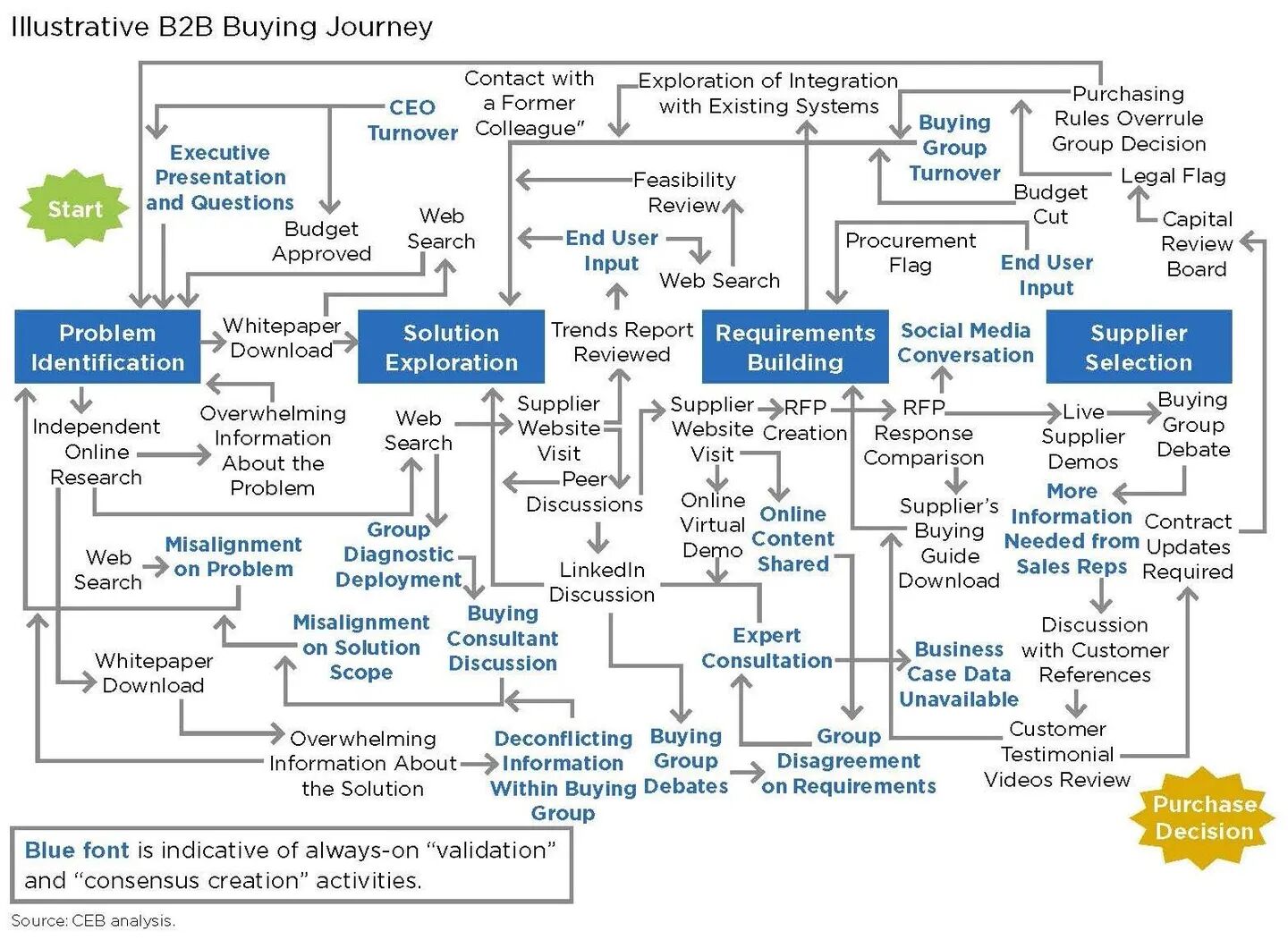

B2C customer journeys are even more peculiar. Remember that time when you saw an ad and bought that product immediately? Or conversely, how the journey from see to buy lasted for years. I know I can:


But content marketers shouldn’t try to solve that maze, or cut a straight line through it just for their convenience. They should rather adapt to it.
2. Tries to fit round pegs in square holes
Not all content types can be, nor should be, fit into rigid stages of the funnel, as the model wants it.
Here’s an example based on one of our articles. Which stage(s) of the marketing funnel does our blog post about “How to find low competition keywords” serve?
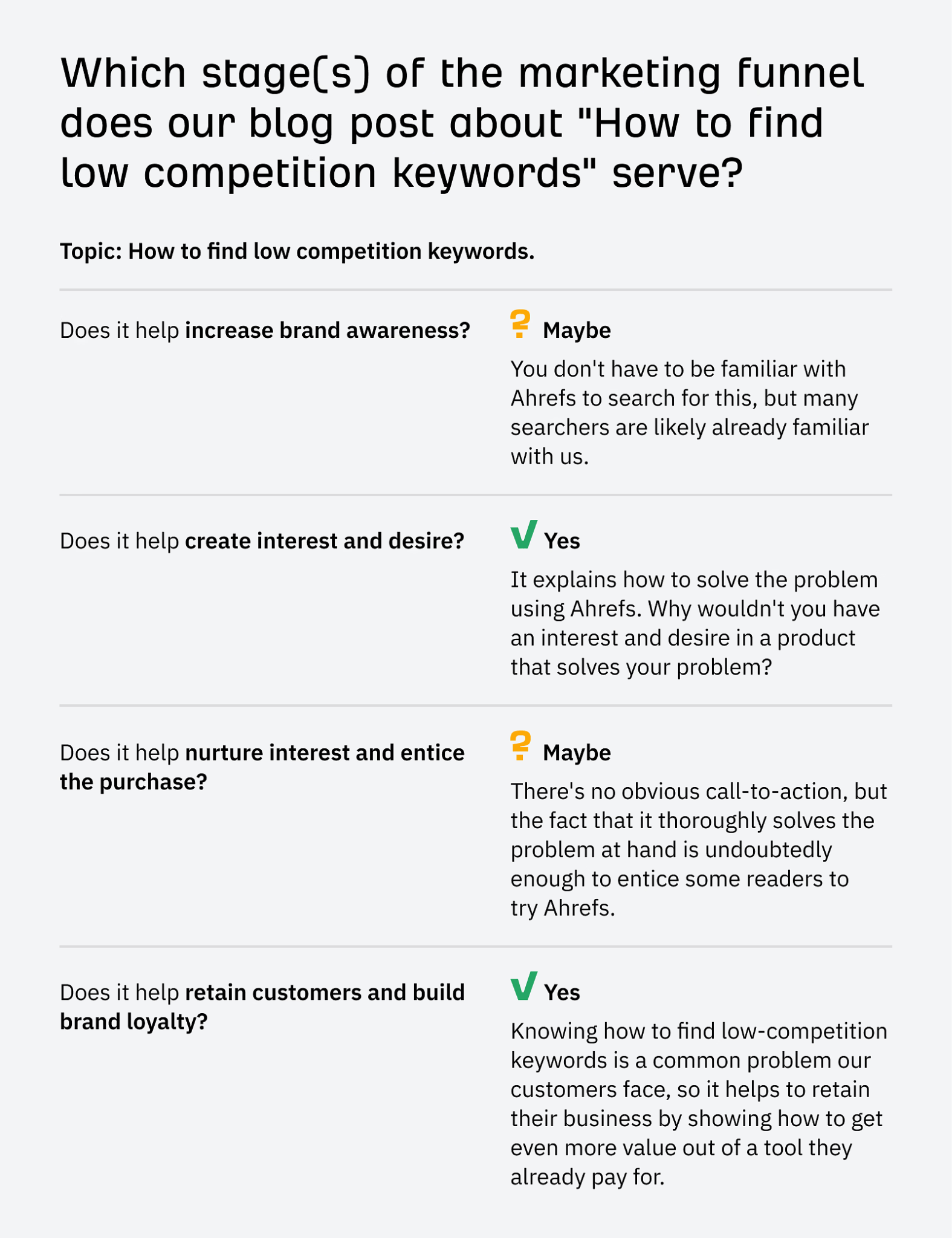

As you can see, the model can’t handle one of the basic forms of content marketing – a blog post. But take any type of educational content, and you’ll find the same problem. Many content types can serve multiple stages of the funnel or work across them. They can both attract and reengage a visitor or even bring them all the way from discovery to purchase.
Because of that, the content marketing funnel simply isn’t helpful for creating content that’s enjoyable for the user and effective for the business.
3. Neglects customer retention
Customer retention is how good you are at keeping your customers. It’s important because you don’t want customers to buy just once from you; you want to keep coming back so that you don’t need to attract a total stranger each time to make a sale — that’s both hard and expensive.
Here’s another way to look at it. According to the study by Bain and Company, increasing customer retention rates by 5% increases profits by 25% to 95%. And it makes total sense if you think about it — if someone asked you to generate an extra $1000 in sales in 24 hours, would you go to existing customers or try to find new ones?
But if you’re practicing the old ways of the funnel, catering to your existing customers is very limited because the funnel ends at the purchase stage. There’s nothing a content marketer can do nor should do after a prospect becomes a customer.
It’s having a party where you’re so focused on inviting new guests that you forget to entertain the ones already inside.
4. Ignores customer expansion
If you only chase new customers and forget about the ones you already have, you miss the chance to make more sales to them or get them to recommend your business to others. Happy customers can really boost your business by buying more and telling their friends about you.
How can content help with that? One good way is to create product-led content. This type of content is designed to show how your product can solve the customer’s problem.
The mechanism is simple: showing product features in action turns a regular user into a power user. They start to use more features and get better value from them, which builds loyalty and gives you a good ground for upselling.
And if that content is really good, people will share it with others, amplifying your brand’s reach.
The best thing: good content will be recommended not only by your customers. People don’t really need to be your customers or know a lot about your brand to give your content a shout-out on social media.
The best solution to the shortcomings of the funnel is to have no funnel at all. Here’s why:
- Adapting to consumer behavior, not forcing it. Focus on how consumers naturally interact with content rather than trying to dictate their journey. Make your content easily accessible without imposing how it should be consumed.
- A more efficient use of content marketing. Content can work both pre-sales and post-sales. It doesn’t have to be useful in one moment in time. It can be designed to stay useful and relevant over time.
- A more helpful way to create content. No time wasted on deciding whether that guide you’re about to write belongs to the top or middle of the funnel. You can simply focus on delivering value and delighting your audience.
Here are three different no-funnel models that share those advantages.
This approach is about using your content to directly boost demand for your product, whether before or after a sale.
Instead of sorting content by stages of a sales funnel, you rate it based on how closely it relates to your product.
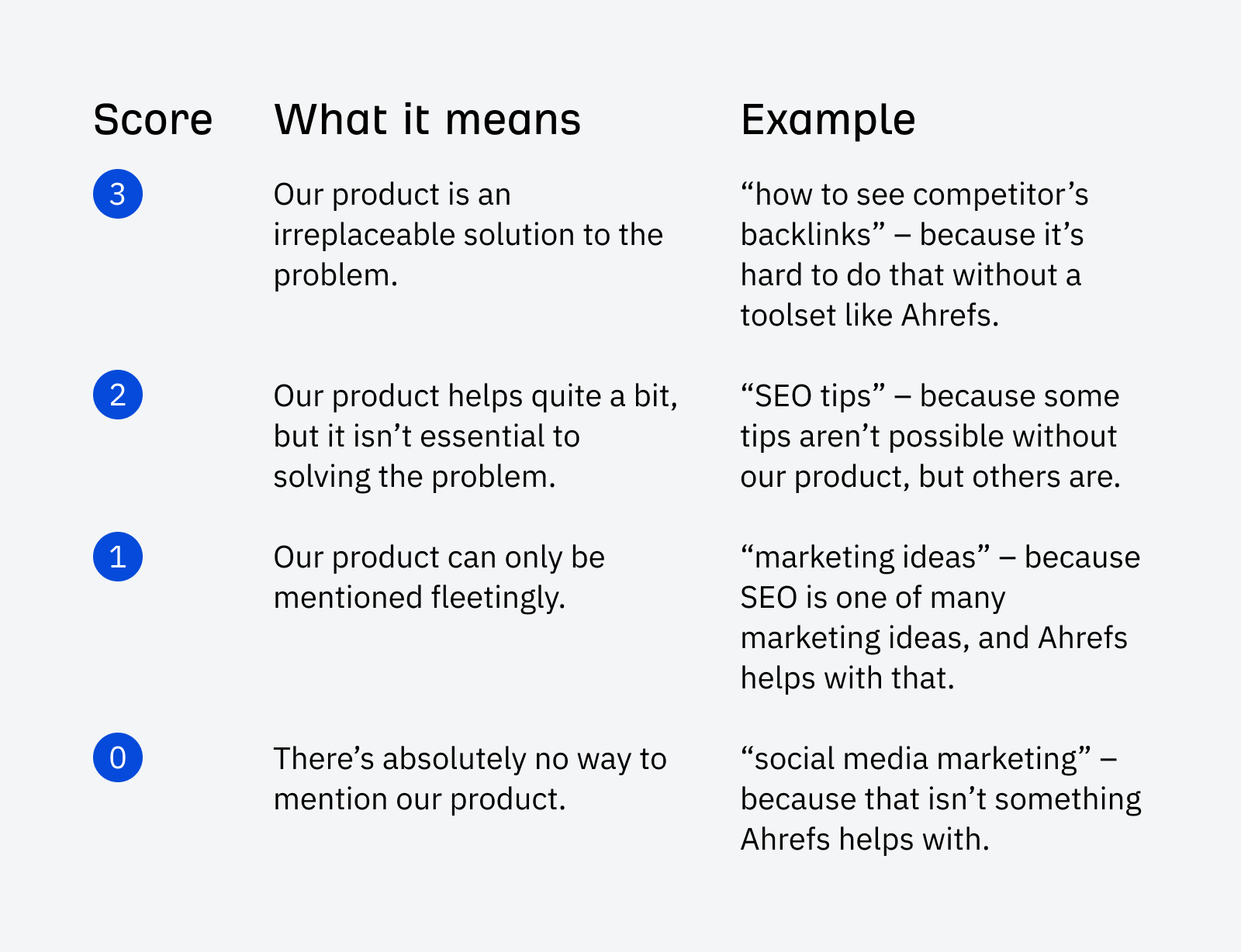

So for example, for a content marketing tool, topics with high business potential would include content marketing metrics, “B2B content marketing”, “content ideation”, “content optimization”, and “content distribution” (and not an interview with content marketers or “history of content marketing”, etc.).
This scoring system makes planning your content strategy really easy. You can quickly decide how much of each type of content to make. Also, you can use it with other important metrics (we use it with organic traffic potential) to further prioritize content.
Ahrefs has been using this model for years, especially for SEO content, which is most of what we publish. It’s great for understanding which search terms are most valuable.
Take these two keywords below as an example. The first one has a lot more traffic potential but is too broad to easily include our product — it would get a “1.” Conversely, the keyword with less traffic but more focused on SEO would get a “3” because it’s more relevant to our customers and our product.


The Business Potential Framework might be a good fit for you if you’re working in an established industry, where there’s already considerable demand for content directly linked to products like yours. This will make it easier to find topics with a score of 2 and 3. You can gauge that demand by looking at search volume in our free keywords generator.


The Content Playground, devised by Ashley Faus, reimagines the buyer’s journey as an open, interactive space, akin to a playground, moving away from the traditional funnel’s linear path.
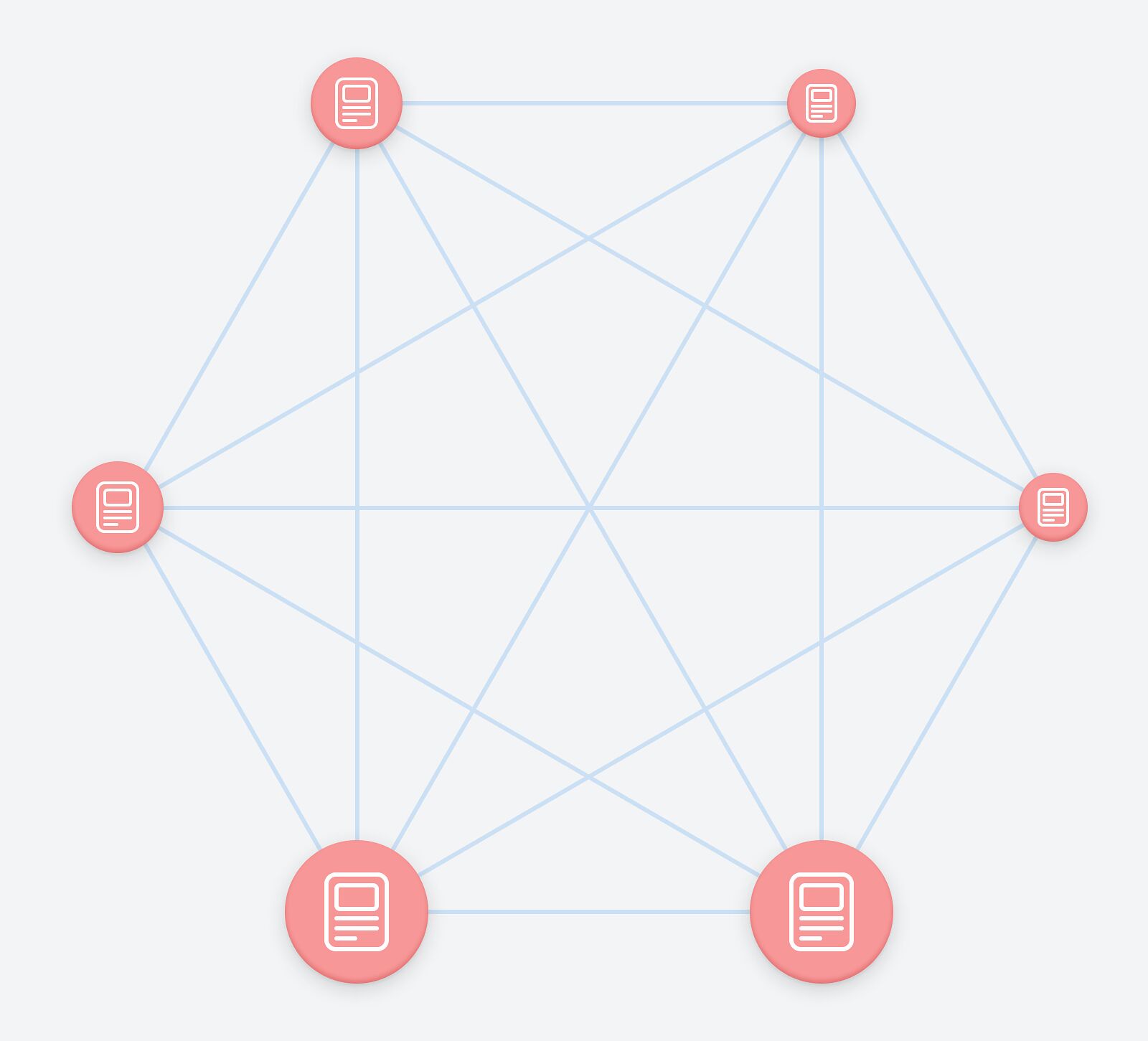

It aims to cater to varied audience interests and learning styles by offering a mix of deep dives, strategic frameworks, and practical tips. To achieve this, it covers topics in three levels:
- Conceptual: covering big ideas and their significance.
- Strategic: outlining frameworks and processes.
- Tactical: providing specific, actionable steps.
Staying with the content marketing tool example, topics you would create content about could look like this: “what is content marketing” (conceptual), “developing a content marketing strategy” (strategic), “how to promote content” (tactical).
To illustrate, this content hub on Agile from Atlassian is designed to be a content playground. There is a mix of all three types of content, and the user can start at any point, go as deep as they like, and jump to another topic at any time.


Naturally, the content needs to be interlinked and ungated so consumers may access it however they want and navigate through it freely. The bonus of that is getting organic traffic from related keywords. According to Ahrefs, this one hub attracts over 591k organic visits every month, and it looks like it’s about to get more.


But a playground doesn’t need to be confined to one site. As long as you tackle a topic with these three types and allow people to access them freely, you can have it scattered across a limitless number of sites and platforms: microsites, blog posts, social media, email, ebooks, etc.
I had a brief chat with Ashley, the mind behind this framework, to understand where this framework fits best. I learned that the framework was developed and tested with B2B marketers in mind, and that’s where it’s most relevant. B2C marketers simply don’t have as big of a problem with customers “coming and going” and re-engaging them on different channels.
There is a way to cover all customer intents, topics, journey stages, and key marketing channels naturally by simply focusing on what matters to your audience and where they are willing to consume content. I call it the Cluster-Channel Network (CCN).
Two core elements of the framework are:
- Clusters: thematic groupings of content around a central topic, supported by a network of related subtopics. They represent things people care about.
- Channels: platforms and mediums through which your message reaches your audience. They represent meeting places that bring you and your audience together to talk about things they care about. Think advertising, email, social media, Google, etc.
CCN ensures a multi-channel presence with content that both attracts your audience and makes your brand an authority in a carefully picked selection of topics.
What’s more, this is an efficient framework because it allows you to “squeeze out” the most of any topic. That’s an important benefit because there are only so many topics a brand can comfortably cover, without creating turning into a content farm spinning irrelevant content just for the sake of traffic.
The framework consists of five steps.
- Identify relevant clusters: choose clusters aligned with your brand’s expertise and audience interests.
- Define subtopics: within each cluster, pinpoint subtopics for comprehensive coverage.
- Produce core content: select a primary channel and format for in-depth content, making this your centerpiece to attract traffic from other platforms.
- Distribute across channels: repurpose the core content into smaller, channel-specific formats.
- Interlink clusters and subtopics: connect related clusters and subtopics. Chances are, people interested in more than one cluster (e.g. SEO and content marketing).
If we were to visualize this framework consisting of four clusters, it would look something like this:


So if we used content marketing as a cluster, one of the subtopics could be AI content. For that subtopic, you could create a blog post about ethics in content marketing in the AI era and distribute it as a thread on X, offer that topic to podcast hosts, etc.
This framework will work best if you have the resources to be present on multiple channels and you’re committed to long-term goals (building trust and authority takes time).
Tip
You can find clusters and subtopics very fast using Ahrefs’ Keywords Explorer. Just plug a broad term related to your product (your cluster), and let AI do the brainstorming.


From a bit over 10 keywords the AI found for me for the word “SEO”, Keywords Explorer found over 32k keywords which then organized into 3466 ready-to-target topics in a matter of seconds. All with traffic potential and keyword difficulty metrics to help with prioritization.


Final thoughts
On a final note, the topics you choose to cover are as important as these frameworks. Check out our guide to content ideation to never run out of ideas.
SEO
Google March 2024 Core Update Officially Completed A Week Ago

Google has officially completed its March 2024 Core Update, ending over a month of ranking volatility across the web.
However, Google didn’t confirm the rollout’s conclusion on its data anomaly page until April 26—a whole week after the update was completed on April 19.
Many in the SEO community had been speculating for days about whether the turbulent update had wrapped up.
The delayed transparency exemplifies Google’s communication issues with publishers and the need for clarity during core updates
Google March 2024 Core Update Timeline & Status
First announced on March 5, the core algorithm update is complete as of April 19. It took 45 days to complete.
Unlike more routine core refreshes, Google warned this one was more complex.
Google’s documentation reads:
“As this is a complex update, the rollout may take up to a month. It’s likely there will be more fluctuations in rankings than with a regular core update, as different systems get fully updated and reinforce each other.”
The aftershocks were tangible, with some websites reporting losses of over 60% of their organic search traffic, according to data from industry observers.
The ripple effects also led to the deindexing of hundreds of sites that were allegedly violating Google’s guidelines.
Addressing Manipulation Attempts
In its official guidance, Google highlighted the criteria it looks for when targeting link spam and manipulation attempts:
- Creating “low-value content” purely to garner manipulative links and inflate rankings.
- Links intended to boost sites’ rankings artificially, including manipulative outgoing links.
- The “repurposing” of expired domains with radically different content to game search visibility.
The updated guidelines warn:
“Any links that are intended to manipulate rankings in Google Search results may be considered link spam. This includes any behavior that manipulates links to your site or outgoing links from your site.”
John Mueller, a Search Advocate at Google, responded to the turbulence by advising publishers not to make rash changes while the core update was ongoing.
However, he suggested sites could proactively fix issues like unnatural paid links.
“If you have noticed things that are worth improving on your site, I’d go ahead and get things done. The idea is not to make changes just for search engines, right? Your users will be happy if you can make things better even if search engines haven’t updated their view of your site yet.”
Emphasizing Quality Over Links
The core update made notable changes to how Google ranks websites.
Most significantly, Google reduced the importance of links in determining a website’s ranking.
In contrast to the description of links as “an important factor in determining relevancy,” Google’s updated spam policies stripped away the “important” designation, simply calling links “a factor.”
This change aligns with Google’s Gary Illyes’ statements that links aren’t among the top three most influential ranking signals.
Instead, Google is giving more weight to quality, credibility, and substantive content.
Consequently, long-running campaigns favoring low-quality link acquisition and keyword optimizations have been demoted.
With the update complete, SEOs and publishers are left to audit their strategies and websites to ensure alignment with Google’s new perspective on ranking.
Core Update Feedback
Google has opened a ranking feedback form related to this core update.
You can use this form until May 31 to provide feedback to Google’s Search team about any issues noticed after the core update.
While the feedback provided won’t be used to make changes for specific queries or websites, Google says it may help inform general improvements to its search ranking systems for future updates.
Google also updated its help documentation on “Debugging drops in Google Search traffic” to help people understand ranking changes after a core update.
Featured Image: Rohit-Tripathi/Shutterstock
FAQ
After the update, what steps should websites take to align with Google’s new ranking criteria?
After Google’s March 2024 Core Update, websites should:
- Improve the quality, trustworthiness, and depth of their website content.
- Stop heavily focusing on getting as many links as possible and prioritize relevant, high-quality links instead.
- Fix any shady or spam-like SEO tactics on their sites.
- Carefully review their SEO strategies to ensure they follow Google’s new guidelines.
SEO
Google Declares It The “Gemini Era” As Revenue Grows 15%

Alphabet Inc., Google’s parent company, announced its first quarter 2024 financial results today.
While Google reported double-digit growth in key revenue areas, the focus was on its AI developments, dubbed the “Gemini era” by CEO Sundar Pichai.
The Numbers: 15% Revenue Growth, Operating Margins Expand
Alphabet reported Q1 revenues of $80.5 billion, a 15% increase year-over-year, exceeding Wall Street’s projections.
Net income was $23.7 billion, with diluted earnings per share of $1.89. Operating margins expanded to 32%, up from 25% in the prior year.
Ruth Porat, Alphabet’s President and CFO, stated:
“Our strong financial results reflect revenue strength across the company and ongoing efforts to durably reengineer our cost base.”
Google’s core advertising units, such as Search and YouTube, drove growth. Google advertising revenues hit $61.7 billion for the quarter.
The Cloud division also maintained momentum, with revenues of $9.6 billion, up 28% year-over-year.
Pichai highlighted that YouTube and Cloud are expected to exit 2024 at a combined $100 billion annual revenue run rate.
Generative AI Integration in Search
Google experimented with AI-powered features in Search Labs before recently introducing AI overviews into the main search results page.
Regarding the gradual rollout, Pichai states:
“We are being measured in how we do this, focusing on areas where gen AI can improve the Search experience, while also prioritizing traffic to websites and merchants.”
Pichai reports that Google’s generative AI features have answered over a billion queries already:
“We’ve already served billions of queries with our generative AI features. It’s enabling people to access new information, to ask questions in new ways, and to ask more complex questions.”
Google reports increased Search usage and user satisfaction among those interacting with the new AI overview results.
The company also highlighted its “Circle to Search” feature on Android, which allows users to circle objects on their screen or in videos to get instant AI-powered answers via Google Lens.
Reorganizing For The “Gemini Era”
As part of the AI roadmap, Alphabet is consolidating all teams building AI models under the Google DeepMind umbrella.
Pichai revealed that, through hardware and software improvements, the company has reduced machine costs associated with its generative AI search results by 80% over the past year.
He states:
“Our data centers are some of the most high-performing, secure, reliable and efficient in the world. We’ve developed new AI models and algorithms that are more than one hundred times more efficient than they were 18 months ago.
How Will Google Make Money With AI?
Alphabet sees opportunities to monetize AI through its advertising products, Cloud offerings, and subscription services.
Google is integrating Gemini into ad products like Performance Max. The company’s Cloud division is bringing “the best of Google AI” to enterprise customers worldwide.
Google One, the company’s subscription service, surpassed 100 million paid subscribers in Q1 and introduced a new premium plan featuring advanced generative AI capabilities powered by Gemini models.
Future Outlook
Pichai outlined six key advantages positioning Alphabet to lead the “next wave of AI innovation”:
- Research leadership in AI breakthroughs like the multimodal Gemini model
- Robust AI infrastructure and custom TPU chips
- Integrating generative AI into Search to enhance the user experience
- A global product footprint reaching billions
- Streamlined teams and improved execution velocity
- Multiple revenue streams to monetize AI through advertising and cloud
With upcoming events like Google I/O and Google Marketing Live, the company is expected to share further updates on its AI initiatives and product roadmap.
Featured Image: Sergei Elagin/Shutterstock
SEO
brightonSEO Live Blog

Hello everyone. It’s April again, so I’m back in Brighton for another two days of Being the introvert I am, my idea of fun isn’t hanging around our booth all day explaining we’ve run out of t-shirts (seriously, you need to be fast if you want swag!). So I decided to do something useful and live-blog the event instead.
Follow below for talk takeaways and (very) mildly humorous commentary. sun, sea, and SEO!
-

 WORDPRESS7 days ago
WORDPRESS7 days ago7 Best WooCommerce Points and Rewards Plugins (Free & Paid)
-

 MARKETING7 days ago
MARKETING7 days agoBattling for Attention in the 2024 Election Year Media Frenzy
-

 WORDPRESS6 days ago
WORDPRESS6 days ago13 Best HubSpot Alternatives for 2024 (Free + Paid)
-

 MARKETING6 days ago
MARKETING6 days agoAdvertising in local markets: A playbook for success
-

 SEO7 days ago
SEO7 days agoGoogle Answers Whether Having Two Sites Affects Rankings
-

 SEARCHENGINES6 days ago
SEARCHENGINES6 days agoGoogle Core Update Flux, AdSense Ad Intent, California Link Tax & More
-

 AFFILIATE MARKETING7 days ago
AFFILIATE MARKETING7 days agoGrab Microsoft Project Professional 2021 for $20 During This Flash Sale
-

 PPC4 days ago
PPC4 days ago10 Most Effective Franchise Marketing Strategies




![The Current State of Google’s Search Generative Experience [What It Means for SEO in 2024] person typing on laptop with](https://articles.entireweb.com/wp-content/uploads/2024/04/The-Current-State-of-Googles-Search-Generative-Experience-What-It.webp-400x240.webp)
![The Current State of Google’s Search Generative Experience [What It Means for SEO in 2024] person typing on laptop with](https://articles.entireweb.com/wp-content/uploads/2024/04/The-Current-State-of-Googles-Search-Generative-Experience-What-It.webp-80x80.webp)









